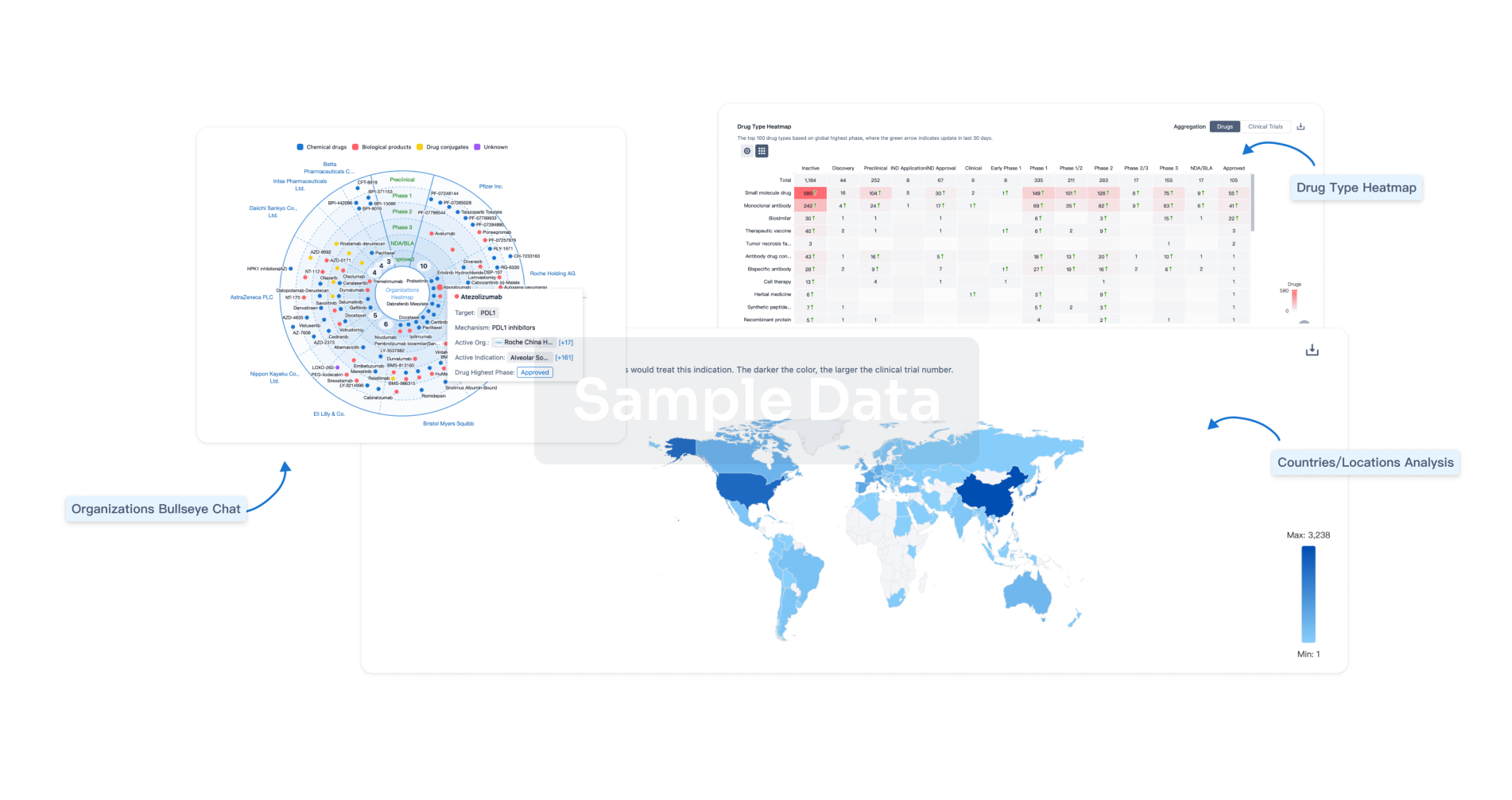Request Demo
Last update 08 May 2025
Campomelic Dysplasia
Last update 08 May 2025
Basic Info
Synonyms CAMPOMELIC DYSPLASIA, CAMPTOMELIC DYSPLASIA, CMD1 + [46] |
Introduction A congenital disorder of CHONDROGENESIS and OSTEOGENESIS characterized by hypoplasia of endochondral bones. In most cases there is a curvature of the long bones especially the TIBIA with dimpling of the skin over the bowed areas, malformation of the pelvis and spine, 11 pairs of ribs, hypoplastic scapulae, club feet, micrognathia, CLEFT PALATE, tracheobronchomalacia, and in some patients male-to-female sex reversal (SEX REVERSAL, GONADAL). Most patients die in the neonatal period of respiratory distress. Campomelic dysplasia is associated with haploinsufficiency of the SOX9 TRANSCRIPTION FACTOR gene. |
Related
1
Drugs associated with Campomelic DysplasiaTarget |
Mechanism PD-1 inhibitors |
Active Org. |
Originator Org. |
Active Indication |
Inactive Indication |
Drug Highest PhaseApproved |
First Approval Ctry. / Loc. Japan |
First Approval Date04 Jul 2014 |
3
Clinical Trials associated with Campomelic DysplasiaNCT04740190
Combination Talazoparib - Carboplatin for Recurrent High-grade Glioma With DNA Damage Repair Deficiency (DDRd)
In view of the strong biological rationale of employing PARP inhibition in high grade glioma, the current study purposes testing of talazoparib in a biomarker-enriched group of glioma. Carboplatin will be added to sensitize the tumor to PARP inhibition, and low dose radiation therapy will be applied to increase talazoparib drug penetration through blood-brain barrier. The goal is to estimate the effect size of such combinational treatment approach in recurrent high-grade glioma with DNA damage repair deficiency (dDDR)
Start Date01 Jan 2021 |
Sponsor / Collaborator |
NCT04126070
A Phase 2 Multicohort Study of Nivolumab in Combination with Docetaxel and Androgen Deprivation Therapy in Metastatic Hormone Sensitive Prostate Cancer Patients with DNA Damage Repair Defects or Inflamed Tumors
This research study is studying a combination of hormonal therapy, chemotherapy, and immunotherapy as a possible treatment for metastatic hormone-sensitive prostate cancer. The names of the study drugs involved in this study are:
* Androgen deprivation therapy (ADT) with a drug of your physician's choice. This may include leuprolide (Lupron), goserelin acetate (Zoladex), or degarelix (Firmagon).
* Docetaxel
* Nivolumab
* Androgen deprivation therapy (ADT) with a drug of your physician's choice. This may include leuprolide (Lupron), goserelin acetate (Zoladex), or degarelix (Firmagon).
* Docetaxel
* Nivolumab
Start Date11 May 2020 |
Sponsor / Collaborator |
ACTRN12618001157268
A Phase 1, Double-Blind, Randomized, Placebo-Controlled, Dose Escalation Trial Evaluating Safety, Tolerability and Pharmacokinetics of Subcutaneous Single Doses of ACP-015 in Healthy Adult Male Subjects.
Start Date08 May 2018 |
Sponsor / Collaborator |
100 Clinical Results associated with Campomelic Dysplasia
Login to view more data
100 Translational Medicine associated with Campomelic Dysplasia
Login to view more data
0 Patents (Medical) associated with Campomelic Dysplasia
Login to view more data
586
Literatures (Medical) associated with Campomelic Dysplasia01 Apr 2025·Human Genetics and Genomics Advances
Missense variants weakening a SOX9 phosphodegron linked to odontogenesis defects, scoliosis, and other skeletal features
Article
Author: Fellah, Hassan ; Karvande, Anirudha ; Barakat, Abdelhamid ; El Alloussi, Mustapha ; Saih, Asmae ; Haseeb, Abdul ; Wakrim, Lahcen ; AitRaise, Imane ; Amalou, Ghita ; Ettaki, Imane ; Hamdi, Salsabil ; Lefebvre, Véronique
28 Jan 2025·Proceedings of the National Academy of Sciences
Variants in the SOX9 transactivation middle domain induce axial skeleton dysplasia and scoliosis
Article
Author: Nie, Xiangyu ; Lin, Mao ; Liu, Lian ; Song, Christina J. ; Liu, Jiaqi ; Li, Qing ; Niu, Yuchen ; Wu, Nan ; Zhu, Yuanpeng ; Zhang, Yuanqiang ; Cai, Jihao ; Zhao, Lina ; Li, Ziquan ; He, Jingyu ; Wen, Wen ; Wang, Lianlei ; Chen, Zefu ; Qiu, Cheng ; Zhang, Jianguo ; Liu, Fei ; Qiu, Guixing ; Gray, Ryan S. ; Liu, Qing ; Xia, Junjie ; Zheng, Zhifa ; Liu, Di ; Wang, Shengru ; Lin, Jiachen ; Zhao, Zhengye ; Yuan, Suomao ; Shao, Jiashen ; Zhao, Hengqiang ; Han, Jialuo ; Wu, Zhihong ; Yin, Xiangjie ; Zhu, Shufang ; Cheng, Xi ; Ye, Yongyu ; Li, Xiaoxin ; Xie, Jingyi ; Yang, Jianle ; Yang, Xinyu ; Li, Guozhuang ; Zhang, Terry Jianguo ; Qiu, Luyuan ; Zhao, Sen ; Feng, Hong Colleen ; Yu, Chenxi ; Gao, Guangxi ; Liu, Sen ; Maheshati, Aoran ; Yang, Yang ; Liu, Xinyu ; Chen, Na ; Bai, Yueyan ; Xu, Kexin ; Zhang, Ning ; Ma, Samuel ; Aceves, Valeria ; Wang, Jie ; Bian, Fangzhou ; Yan, Zihui ; Fang, Kun ; Liu, Ze ; Chen, Guilin ; Troutwine, Benjamin ; Liu, Zhaoyang ; Li, Zihua
01 Dec 2024·Journal of Cellular Physiology
Dissecting SOX9 dynamics reveals its differential regulation in osteoarthritis
Article
Author: Karperien, Marcel ; Post, Janine N. ; Govindaraj, Kannan ; Kannan, Sakshi ; Jansen Klomp, Lucas ; Meulenbelt, Ingrid ; Coutinho de Almeida, Rodrigo
1
News (Medical) associated with Campomelic Dysplasia15 Dec 2022
Scientists have uncovered the underlying cause of deafness caused by swelling of the chambers in the inner ear. Using a mouse model of a human congenital disorder that displays deafness, the researchers identified two master genes controlling hearing function, which opened a new pathway for diagnosis of deafness and balance problems, and possibly to the effects on stem cells in other tissues and syndromes.
An international team of scientists led by the LKS Faculty of Medicine, the University of Hong Kong (HKUMed) has uncovered the underlying cause of deafness caused by swelling of the chambers in the inner ear. Using a mouse model of a human congenital disorder that displays deafness, the researchers identified two master genes controlling hearing function, which opened a new pathway for diagnosis of deafness and balance problems, and possibly to the effects on stem cells in other tissues and syndromes. This exciting advance is described in their paper published in the Proceedings of the National Academy of Sciences.
Background
Hearing and balance require a functioning inner ear, which houses the sensory organs, and a system that mediates the transmission of sound through a fluid filled chamber called the endolymphatic system, composed of the endolymphatic duct and sac. These tissues help to control the amount of ions within the fluid (called endolymph) in the inner ear and thereby enable sound and balance signals to be transmitted to the nerves and the brain. Impairment of the endolymphatic system is a common cause of deafness. The endolymph is essential for hearing function. Dysfunction of this fluid results in swelling of the endolymphatic sac (called hydrops) causing hearing loss, vertigo, aural fullness and pain.
HKUMed scientists, leading an international research team, generated and studied mouse models of a human disorder called campomelic dysplasia (CD), a syndrome characterised in part by deafness of unknown etiology. The team found that the underlying cause of the deafness is deficiency for two master regulatory factors, called SOX9 and SOX10 (collectively called SOXE genes). These factors were found to orchestrate the generation of stem cells in the development of the inner ear. When these SOXE genes were deficient, the result is insufficient supply of mature cells that are responsible for ensuring proper ionic composition of the endolymph and a functioning endolymphatic system. As a consequence, the chambers of the inner ear become swollen, causing deafness.
Significance
Human hearing loss leads to physical disabilities and generates difficulties in education, employment and social life. One in 10 people is estimated to experience hearing loss by 2050 and 1-3 newborns per thousand are hearing impaired, of which 50% are due to genetic causes. Malfunction affecting the ionic composition in the endolymph is the most common causes of deafness. Because SOXE genes are master controllers of many other genes, a further importance of the study is that it provides a rich resource for the discovery of other candidate congenital deafness genes or identify disease genes regulated by the SOXE factors. The resource could be a guide for diagnosis of deafness and balance problems. Since SOXE genes have many roles in development and in stem cells, the principles found could be applicable to effects on stem cells in general in other tissues and syndromes.
Professor Kathryn Cheah Song Eng, Jimmy and Emily Tang Professor of Molecular Genetics and Chair Professor of Biochemistry, School of Biomedical Sciences, HKUMed, who led the study said, "Being deaf can have deep psychological and social impact on the affected individual. Discovering the master controllers of the sound conducting system in the inner ear provides insights into the disease mechanism that will help development of treatment that will have enormous impact on the many people with hearing loss."
Dr Brian Chung Hon-yin, Clinical Geneticist/Clinical Associate Professor, Department of Paediatrics and Adolescent Medicine, School of Clinical Medicine, HKUMed, also commented, "Congenital deafness is an important indication of referral in clinical genetics. Patients with both syndromic and non-syndromic hearing loss are frequently encountered. Despite recent studies suggesting a genetic diagnosis in up to 50% of patients, the underlying pathophysiology remains complex and poorly understood. This exciting work shows convincing evidence of the partnership between SOX9 and SOX10 in controlling the development of the endolymphatic system. It sheds light on the future direction for research of clinical geneticists and scientists in deciphering other conditions of hearing impairment."
About the research team
This collaborative study was led by Professor Kathryn Cheah, Jimmy and Emily Tang Professor in Molecular Genetics and Chair Professor of Biochemistry, School of Biomedical Sciences, HKUMed and involved postdoctoral fellows, research postgraduates and scientists from The Chinese University of Hong Kong (CUHK) and international research institutions. Other scientists contributing to the research included Professor Chan Ying-shing, Dr Ralf Jauch and Professor Sham Mai-har (currently in CUHK), of the School of Biomedical Sciences, HKUMed; Professor Chan Wood-yee of the School of Biomedical Science, CUHK. International collaborators were Professor Robin Lovell-Badge of the Francis Crick Institute in London, the United Kingdom and Professor Bernd Fritsch of the University of Iowa, the United States.
Acknowledgements
The work was supported by funding from the University Grants Committee Areas of Excellence Scheme, Research Grants Council General Research Fund, Theme-Based Research Schemes (HKU7222/97M, HKU2/02C, HKU4/05C, AoE/M-04/04, T12-708/12N) and the Jimmy and Emily Tang Professorship.
Analysis
Perform a panoramic analysis of this field.
login
or

AI Agents Built for Biopharma Breakthroughs
Accelerate discovery. Empower decisions. Transform outcomes.
Get started for free today!
Accelerate Strategic R&D decision making with Synapse, PatSnap’s AI-powered Connected Innovation Intelligence Platform Built for Life Sciences Professionals.
Start your data trial now!
Synapse data is also accessible to external entities via APIs or data packages. Empower better decisions with the latest in pharmaceutical intelligence.
Bio
Bio Sequences Search & Analysis
Sign up for free
Chemical
Chemical Structures Search & Analysis
Sign up for free



